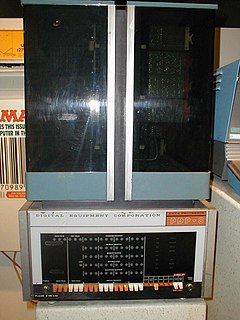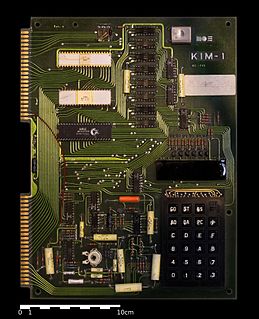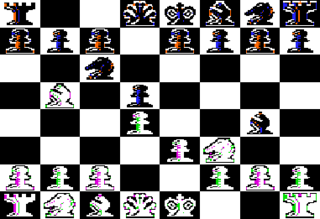
In computer programming, assembly language, is any low-level programming language in which there is a very strong correspondence between the instructions in the language and the architecture's machine code instructions. Assembly language usually has one statement per machine instruction (1:1), but constants, comments, assembler directives, symbolic labels of, e.g., memory locations, registers, and macros are generally also supported.

BASIC is a family of general-purpose, high-level programming languages designed for ease of use. The original version was created by John G. Kemeny and Thomas E. Kurtz at Dartmouth College in 1964. They wanted to enable students in non-scientific fields to use computers. At the time, nearly all computers required writing custom software, which only scientists and mathematicians tended to learn.

The Intel 8080 ("eighty-eighty") is the second 8-bit microprocessor designed and manufactured by Intel. It first appeared in April 1974 and is an extended and enhanced variant of the earlier 8008 design, although without binary compatibility. The initial specified clock rate or frequency limit was 2 MHz, with common instructions using 4, 5, 7, 10, or 11 cycles. As a result, the processor is able to execute several hundred thousand instructions per second. Two faster variants, the 8080A-1 and 8080A-2, became available later with clock frequency limits of 3.125 MHz and 2.63 MHz respectively. The 8080 needs two support chips to function in most applications: the i8224 clock generator/driver and the i8228 bus controller. It is implemented in N-type metal-oxide-semiconductor logic (NMOS) using non-saturated enhancement mode transistors as loads thus demanding a +12 V and a −5 V voltage in addition to the main transistor–transistor logic (TTL) compatible +5 V.

A minicomputer, or colloquially mini, is a class of smaller general purpose computers that developed in the mid-1960s and sold for much less than mainframe and mid-size computers from IBM and its direct competitors. In a 1970 survey, The New York Times suggested a consensus definition of a minicomputer as a machine costing less than US$25,000, with an input-output device such as a teleprinter and at least four thousand words of memory, that is capable of running programs in a higher level language, such as Fortran or BASIC.

A microcomputer is a small, relatively inexpensive computer having a central processing unit (CPU) made out of a microprocessor. The computer also includes memory and input/output (I/O) circuitry together mounted on a printed circuit board (PCB) Microcomputers became popular in the 1970s and 1980s with the advent of increasingly powerful microprocessors. The predecessors to these computers, mainframes and minicomputers, were comparatively much larger and more expensive. Many microcomputers are also personal computers. An early use of the term personal computer in 1962 predates microprocessor-based designs. (See "Personal Computer: Computers at Companies" reference below). A microcomputer used as an embedded control system may have no human-readable input and output devices. "Personal computer" may be used generically or may denote an IBM PC compatible machine.

BBC BASIC is a version of the BASIC programming language released in 1981 as the native programming language for the BBC Micro home/personal computer, providing a standardized language for a UK computer literacy project of the BBC. It was written mainly by Sophie Wilson.

The Intel 8008 is an early byte-oriented microprocessor designed by Computer Terminal Corporation (CTC), implemented and manufactured by Intel, and introduced in April 1972. It is an 8-bit CPU with an external 14-bit address bus that could address 16 KB of memory. Originally known as the 1201, the chip was commissioned by Computer Terminal Corporation (CTC) to implement an instruction set of their design for their Datapoint 2200 programmable terminal. As the chip was delayed and did not meet CTC's performance goals, the 2200 ended up using CTC's own TTL-based CPU instead. An agreement permitted Intel to market the chip to other customers after Seiko expressed an interest in using it for a calculator.
Small-C is both a subset of the C programming language, suitable for resource-limited microcomputers and embedded systems, and an implementation of that subset. Originally valuable as an early compiler for microcomputer systems available during the late 1970s and early 1980s, the implementation has also been useful as an example simple enough for teaching purposes.

The KIM-1, short for Keyboard Input Monitor, is a small 6502-based single-board computer developed and produced by MOS Technology, Inc. and launched in 1976. It was very successful in that period, due to its low price and easy-access expandability.
In computer architecture, 4-bit integers, or other data units are those that are 4 bits wide. Also, 4-bit central processing unit (CPU) and arithmetic logic unit (ALU) architectures are those that are based on registers, or data buses of that size. Memory addresses (and thus address buses) for 4-bit CPUs are generally much larger than 4-bit (since only 16 memory locations would be very restrictive), such as 12-bit or more, while they could in theory be 8-bit. A group of four bits is also called a nibble and has 24 = 16 possible values.

Sargon is a line of chess-playing software for personal computers. The original SARGON from 1978 was written in assembly language by Dan and Kathleen "Kathe" Spracklen for the Z80-based Wavemate Jupiter III.

A denshi block is a small plastic box containing an electronic component. The blocks are used in some educational electronics kits, such as the Gakken EX-150, to allow experiments to be performed easily and safely.
A source-to-source translator, source-to-source compiler, transcompiler, or transpiler is a type of translator that takes the source code of a program written in a programming language as its input and produces an equivalent source code in the same or a different programming language. A source-to-source translator converts between programming languages that operate at approximately the same level of abstraction, while a traditional compiler translates from a higher level programming language to a lower level programming language. For example, a source-to-source translator may perform a translation of a program from Python to JavaScript, while a traditional compiler translates from a language like C to assembler or Java to bytecode. An automatic parallelizing compiler will frequently take in a high level language program as an input and then transform the code and annotate it with parallel code annotations or language constructs.

A microprocessor development board is a printed circuit board containing a microprocessor and the minimal support logic needed for an electronic engineer or any person that wants to become acquainted with the microprocessor on the board and to learn to program it. It also served users of the microprocessor as a method to prototype applications in products.
William Barden Jr. is an author of books and articles on computer programming. Barden's writings mainly covered microcomputers, computer graphics and assembly language and BASIC programming. He was a contributing editor for The Rainbow magazine in which he wrote a monthly column called Barden's Buffer on low-level assembly language programming on the TRS-80 Color Computer. Some of his books were published under the name William T. Barden. He lives in Scottsdale, Arizona.

Gakken Holdings Co., Ltd. is a Japanese publishing company founded in 1947 by Hideto Furuoka, which also produces educational toys. Their annual sales is reported at ¥ 90 billion.

The British Broadcasting Corporation Microcomputer System, or BBC Micro, is a series of microcomputers and associated peripherals designed and built by Acorn Computers in the 1980s for the BBC Computer Literacy Project. Designed with an emphasis on education, it was notable for its ruggedness, expandability, and the quality of its operating system. An accompanying 1982 television series, The Computer Programme, featuring Chris Serle learning to use the machine, was broadcast on BBC2.
Each time Intel launched a new microprocessor, they simultaneously provided a System Development Kit (SDK) allowing engineers, university students, and others to familiarise themselves with the new processor's concepts and features. The SDK single-board computers allowed the user to enter object code from a keyboard or upload it through a communication port, and then test run the code. The SDK boards provided a system monitor ROM to operate the keyboard and other interfaces. Kits varied in their specific features but generally offered optional memory and interface configurations, a serial terminal link, audio cassette storage, and EPROM program memory. Intel's Intellec development system could download code to the SDK boards.
A binary recompiler is a compiler that takes executable binary files as input, analyzes their structure, applies transformations and optimizations, and outputs new optimized executable binaries.

The Intellec computers were a series of early microcomputers Intel produced in the 1970s as a development platform for their processors. The Intellec computers were among the first microcomputers ever sold, predating the Altair 8800 by at least two years.














